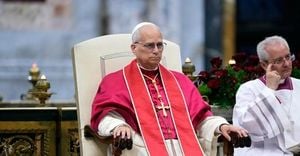On January 28, 1986, the Space Shuttle Challenger tragically exploded just 73 seconds after its liftoff, marking one of NASA's most devastating events and forever changing the face of American space exploration. Now, 39 years later, the memories of this catastrophe are still vivid as the nation remembers the seven astronauts who lost their lives on this fateful day.
The Challenger crew included Commander Francis Scobee, Pilot Michael Smith, Mission Specialists Ronald McNair, Ellison Onizuka, Judith Resnik, Payload Specialist Gregory Jarvis, and the first civilian astronaut, Christa McAuliffe. McAuliffe, selected to be the first teacher in space, sparked immense public interest, particularly among schoolchildren who gathered to watch the launch, eagerly anticipating the educational experiences she would bring from space.
Launching from Kennedy Space Center in Cape Canaveral, the Challenger was on its 10th mission, known as STS-51L. The mission aimed to deploy the Tracking and Data Relay Satellite and to conduct various scientific experiments, including some based on the lessons McAuliffe had prepared to teach to students on Earth. Ironically, the emphasis on this educational mission showcased how close the nation was to achieving new heights—heightened by the knowledge of losing seven heroic individuals.
On the day of the launch, temperatures plummeted to uncharacteristically low levels, dipping as low as 26 degrees Fahrenheit overnight. Engineers at NASA expressed grave concerns about the impact this would have on the launch, as the rubber O-rings, integral seals to the solid rocket boosters, had never been tested under such cold conditions. The extreme weather created both logistical and safety challenges, with ice forming on launch structures and the external tank, which housed the shuttle's fuel.
Despite these warnings, NASA management decided to proceed with the launch. Onlookers, including students, watched anxiously as Challenger lifted off at precisely 11:38 AM. Initially, all seemed well, but at 73 seconds post-liftoff, the nightmare commenced. Witnesses observed the shuttle break apart, resulting from the catastrophic failure of the O-rings, allowing hot gases to escape and trigger the explosion.
President Ronald Reagan addressed the nation later, summoning the words of aviator John Gillespie Magee, "We will never forget them, nor the last time we saw them, this morning, as they prepared for their journeys and waved goodbye." Reagan's remarks echoed throughout America, encapsulating the shock and grief experienced by millions who had watched the launch live.
The aftermath of the Challenger disaster forced NASA to reevaluate its safety protocols. Engaging the Rogers Commission, appointed by the government to investigate, the agency discovered poor decision-making practices and overlooked engineer concerns. The inquiry concluded, "The decision to launch the Challenger was flawed...if the decision-makers had known all the facts, it is highly unlikely they would have proceeded with the launch."
More than just regulatory shifts occurred; this disaster became pivotal for NASA, instigated revisions of management policies and restructuring of safety cultures. The shuttle program was grounded for nearly three years, during which comprehensive safety protocols were developed to prevent such oversights from reoccurring.
Each year, NASA holds its Day of Remembrance to honor the Challenger crew, along with those lost on the Apollo 1 and Columbia missions. This year, the Day of Remembrance was observed on January 23, where NASA officials reflected upon the sacrifices of these pioneers. Their dedication to exploration remains eternal, with the Jonos upcoming endeavors serving as both tribute and motivation to keep advancing the frontiers of space.
Current tributes to the lost crew include the “Forever Remembered” exhibit at the Kennedy Space Center, showcasing personal belongings and artifacts from Challenger's crew. This serves as both stark reminder of the tragedy and homage to the aspiring astronauts who dared to reach beyond.
Despite the heartbreak, the Challenger mission prompted groundbreaking changes within NASA and the wider community it served. Christa McAuliffe’s teaching aspirations were partially fulfilled years later when her planned lessons were conducted by astronauts aboard the International Space Station. The commitment to education inspired by her vision continues today.
The Challenger disaster remains seared not only in NASA's history but within the hearts of those who witnessed it. It acts as both cautionary tale and symbol of courage, embodying the resilient spirit of those who wish to reach the stars. The legacy of the Challenger crew, with their bravery and sacrifice, endures through education, innovation, and the relentless pursuit of knowledge beyond our planet.



